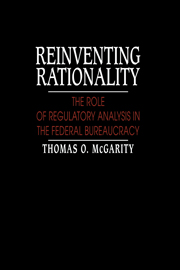Book contents
- Frontmatter
- Contents
- Acknowledgments
- Abbreviations
- Introduction
- Part I The clash of regulatory cultures
- Part II Regulatory analysis in theory and practice
- 3 Getting the lead out of gasoline: EPA's lead phasedown regulations
- 4 Getting the dust out of the air: EPA's ambient air quality standard for particulate matter
- 5 Getting obstructions out of the driver's view: NHTSA's field of direct view regulations
- 6 Getting the bone out of processed meat: FSIS's mechanically separated meat standard
- 7 Getting information into hazardous workplaces: OSHA's hazard identification regulations
- 8 The virtues of regulatory analysis
- 9 Limitations of regulatory analysis
- 10 Regulatory analysis in the real world
- Part III Structuring regulatory analysis into the decisionmaking process
- Part IV Review of regulatory analysis
- Part V Conclusions
- Notes
- Bibliography
- Index
3 - Getting the lead out of gasoline: EPA's lead phasedown regulations
Published online by Cambridge University Press: 16 October 2009
- Frontmatter
- Contents
- Acknowledgments
- Abbreviations
- Introduction
- Part I The clash of regulatory cultures
- Part II Regulatory analysis in theory and practice
- 3 Getting the lead out of gasoline: EPA's lead phasedown regulations
- 4 Getting the dust out of the air: EPA's ambient air quality standard for particulate matter
- 5 Getting obstructions out of the driver's view: NHTSA's field of direct view regulations
- 6 Getting the bone out of processed meat: FSIS's mechanically separated meat standard
- 7 Getting information into hazardous workplaces: OSHA's hazard identification regulations
- 8 The virtues of regulatory analysis
- 9 Limitations of regulatory analysis
- 10 Regulatory analysis in the real world
- Part III Structuring regulatory analysis into the decisionmaking process
- Part IV Review of regulatory analysis
- Part V Conclusions
- Notes
- Bibliography
- Index
Summary
Petroleum refiners have used tetraethyl lead since 1923 as an additive to boost the octane rating of gasoline and reduce “knocking.” By the mid-1970s, approximately 90 percent of all gasoline manufactured in the United States contained tetraethyl lead. Although large gasoline refiners produced most leaded gasoline, a number of smaller companies refined leaded gasoline and supplied tetraethyl lead to large refineries.
Unfortunately, lead can be extremely toxic, especially to children, in high concentrations. At very high blood concentration levels of approximately 120 micrograms of lead per deciliter of blood (μg/dl), lead can cause severe and irreversible brain damage. Children with blood lead levels of over 80 to 100 μg/dl can suffer permanent cognitive impairment. Lead can also have reproductive effects on both men and women. At much lower blood levels of approximately 40 μg/dl, lead can impair the synthesis of hemoglobin and cause anemia.
Lead is ubiquitous in the human environment. It is present in food, water, air, soil, dustfall, paint, and other materials with which humans come into contact. Human exposure to lead can come from a variety of sources, including ingestion of food grown in leadcontaminated soils, ingestion of lead-based paint, inhalation of airborne lead, and ingestion of dust contaminated with airborne lead, the latter route being common among infants with pica, an affliction which causes them to eat dust and dirt. A major source of human exposure to lead is airborne lead, and approximately 90 percent of airborne lead comes from automobiles.
Regulatory background
Congress enacted Section 211 of the Clean Air Act specifically to empower EPA to regulate fuel additives like tetraethyl lead.
- Type
- Chapter
- Information
- Reinventing RationalityThe Role of Regulatory Analysis in the Federal Bureaucracy, pp. 29 - 44Publisher: Cambridge University PressPrint publication year: 1991



